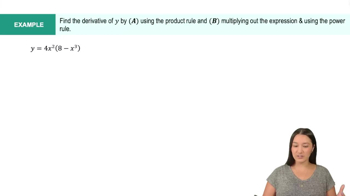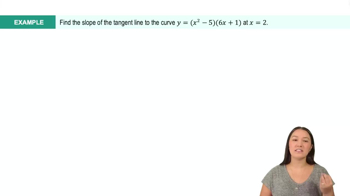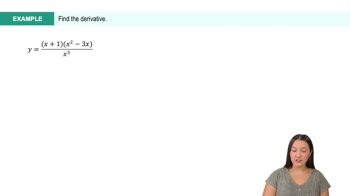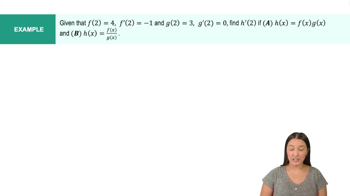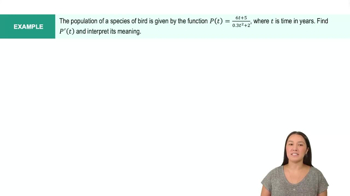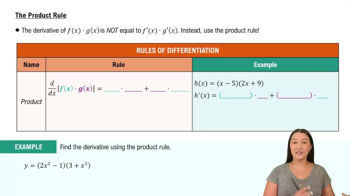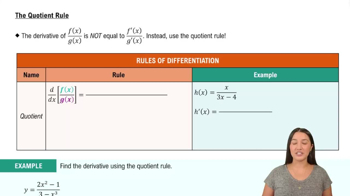Table of contents
- 0. Functions7h 52m
- Introduction to Functions16m
- Piecewise Functions10m
- Properties of Functions9m
- Common Functions1h 8m
- Transformations5m
- Combining Functions27m
- Exponent rules32m
- Exponential Functions28m
- Logarithmic Functions24m
- Properties of Logarithms34m
- Exponential & Logarithmic Equations35m
- Introduction to Trigonometric Functions38m
- Graphs of Trigonometric Functions44m
- Trigonometric Identities47m
- Inverse Trigonometric Functions48m
- 1. Limits and Continuity2h 2m
- 2. Intro to Derivatives1h 33m
- 3. Techniques of Differentiation3h 18m
- 4. Applications of Derivatives2h 38m
- 5. Graphical Applications of Derivatives6h 2m
- 6. Derivatives of Inverse, Exponential, & Logarithmic Functions2h 37m
- 7. Antiderivatives & Indefinite Integrals1h 26m
- 8. Definite Integrals4h 44m
- 9. Graphical Applications of Integrals2h 27m
- 10. Physics Applications of Integrals 2h 22m
3. Techniques of Differentiation
Product and Quotient Rules
Problem 3.57c
Textbook Question
Suppose that functions ƒ(x) and g(x) and their first derivatives have the following values at x = 0 and x = 1.
x ƒ(x) g(x) ƒ'(x) g'(x)
0 1 1 -3 1/2
1 3 5 1/2 -4
Find the first derivatives of the following combinations at the given value of x.
c. ƒ(x) , x = 1
g(x) + 1
 Verified step by step guidance
Verified step by step guidance1
Identify the function combination for which you need to find the derivative. In this case, it is the derivative of the function f(x) with respect to x, evaluated at x = 1.
Recall that the derivative of a function at a point gives the rate of change of the function at that point. Here, you need to find f'(x) at x = 1.
From the given data, locate the value of f'(x) at x = 1. According to the table, f'(1) = 1/2.
Since the problem asks for the derivative of f(x) at x = 1, and you have already identified f'(1) = 1/2, this is the value you need.
Thus, the first derivative of f(x) at x = 1 is 1/2, which represents the slope of the tangent line to the curve of f(x) at that point.
 Verified video answer for a similar problem:
Verified video answer for a similar problem:This video solution was recommended by our tutors as helpful for the problem above
Video duration:
4mPlay a video:
Was this helpful?
Key Concepts
Here are the essential concepts you must grasp in order to answer the question correctly.
Derivative of a Function
The derivative of a function measures how the function's output changes as its input changes. It is defined as the limit of the average rate of change of the function over an interval as the interval approaches zero. In this context, knowing the derivatives of functions ƒ(x) and g(x) at specific points is crucial for finding the derivatives of their combinations.
Recommended video:

Derivatives of Other Trig Functions
Sum Rule of Derivatives
The sum rule states that the derivative of the sum of two functions is equal to the sum of their derivatives. Mathematically, if h(x) = ƒ(x) + g(x), then h'(x) = ƒ'(x) + g'(x). This rule is essential for solving the given problem, as it allows us to find the derivative of the combination ƒ(x) + 1 by simply using the derivative of ƒ(x) since the derivative of a constant (1) is zero.
Recommended video:

Algebra Rules for Finite Sums
Evaluating Derivatives at Specific Points
Evaluating a derivative at a specific point involves substituting the value of x into the derivative function. In this case, we need to find the derivative of the combination at x = 1. This requires using the provided values of the derivatives at that point to compute the final result accurately.
Recommended video:

Critical Points
Related Videos
Related Practice



